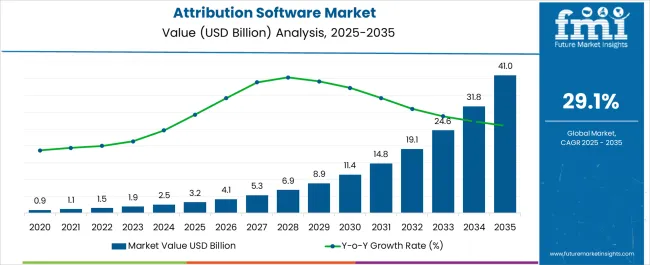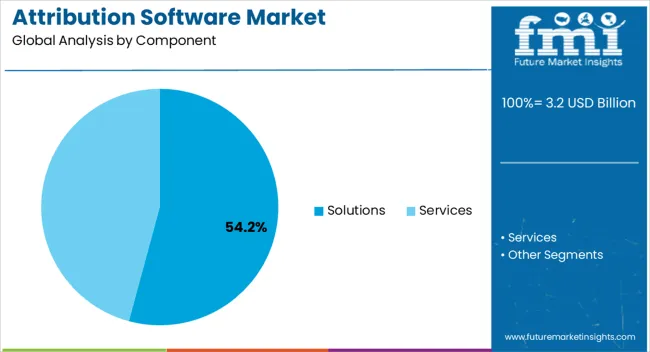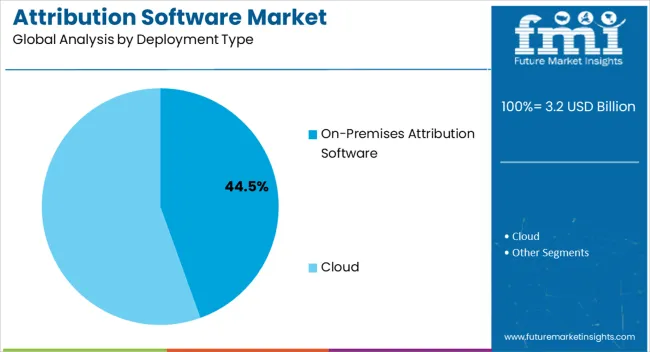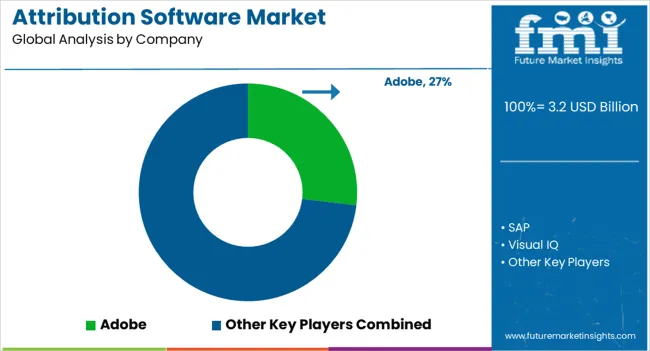The Attribution Software Market is estimated to be valued at USD 3.2 billion in 2025 and is projected to reach USD 41.0 billion by 2035, registering a compound annual growth rate (CAGR) of 29.1% over the forecast period.

| Metric | Value |
|---|---|
| Attribution Software Market Estimated Value in (2025 E) | USD 3.2 billion |
| Attribution Software Market Forecast Value in (2035 F) | USD 41.0 billion |
| Forecast CAGR (2025 to 2035) | 29.1% |
The attribution software market is expanding as enterprises increasingly prioritize accurate measurement of marketing effectiveness and return on investment. Growing digital ad spending, complex multi channel customer journeys, and heightened competition have created the need for solutions that provide deeper insights into consumer behavior.
Businesses are adopting attribution tools to better allocate marketing budgets, optimize channel performance, and enhance personalization strategies. Advancements in AI driven analytics and integration with customer data platforms are further supporting market adoption.
Regulatory compliance with data privacy frameworks is also influencing the way companies deploy attribution models, shaping demand for secure and transparent platforms. The market outlook remains favorable as organizations seek tools that can bridge online and offline touchpoints, providing a comprehensive view of campaign performance and customer acquisition strategies.

The solutions segment is projected to account for 54.20% of the total market revenue by 2025 within the component category, positioning it as the most significant segment. This growth is being supported by the increasing demand for integrated platforms that streamline data collection, visualization, and multi channel analysis.
Solutions provide actionable insights that enable marketers to measure campaign effectiveness, optimize resource allocation, and enhance consumer engagement. The scalability and flexibility of these platforms have reinforced their adoption among enterprises seeking to unify fragmented marketing data.
Continuous innovation and integration with advanced analytics tools have further strengthened the dominance of the solutions segment.
The single source attribution segment is expected to represent 48.70% of total market revenue by 2025 within the attribution type category, making it the leading segment. This preference is attributed to the simplicity of implementation, ease of understanding, and ability to provide quick insights into campaign impact.
Marketers often rely on this model for initial decision making due to its straightforward nature and lower costs compared to more complex models. Adoption has been further reinforced by organizations with limited technical infrastructure, where single source attribution provides a practical entry point.
While more advanced models are being explored, single source attribution continues to dominate due to its accessibility and immediate value.

The on premises deployment segment is projected to hold 44.50% of the total market revenue by 2025 under the deployment type category, positioning it as the leading deployment preference. This dominance is driven by the need for greater control over sensitive customer data, compliance with regional data security regulations, and customizable infrastructure requirements.
Enterprises with complex IT environments and strict governance policies prefer on premises solutions to maintain data integrity and operational oversight. Additionally, large organizations with existing IT infrastructure can optimize costs by integrating attribution software into their own systems.
The combination of security, customization, and regulatory adherence has reinforced the leadership of the on premises segment in the overall attribution software market.
North America dominates the market for Attribution Software, due to the significant presence of large multinational corporations in the region, which primarily contribute to the market’s growth. Additionally, the region's adoption of multi-touch attribution software is expected to be fuelled by businesses' rising need to monitor client behavior to conduct targeted marketing.
The development of attribution software in the region is being supported by technological improvements and businesses' willingness to adopt new, cutting-edge solutions. Additionally, due to the dominance of key competitors in the market who provide multi-touch marketing attribution software, as well as its financial standing, it is able to spend primarily on the top tools and technologies for successful business operations in the region.
| Regional Market Comparison | Global Market Share in Percentage |
|---|---|
| North America | 28% |
| Europe | 22.3% |
The market with great potential for attribution software is Asia Pacific. The main driver of the market expansion in the region has been the existence of multiple large and medium-sized businesses as well as several growing small businesses in nations like China, India, Japan, and South Korea.
Large and medium-sized businesses hugely invest in the most recent technologies to watch consumer behavior and acquire a broad picture of the situation across their customer base. Businesses also make investments in boosting their IT infrastructure so that they can analyze massive data sets to gauge the success of their marketing initiatives. Further, these elements have a significant impact on the market for attribution software.
In the Asia-Pacific, there were about 35% more new small businesses operating in 2024 than there were in 2020, which is high than the global average of 32% and more than eight times the 4% of new large businesses. Further, the countries that show this trend the most are Australia with 73% increase, Japan with a 38% increase, and Thailand with 29% increase. These elements boost the region's demand for attribution software in an indirect manner.
The United States has the dominant market for attribution software, which is projected to be worth more than USD 41 billion by 2035. From 2020 to 2025, the market in the United States expanded at a CAGR of 36.9%. Between 2025 and 2035, the United States is expected to be a market with a USD 6.1 billion absolute dollar opportunity.
According to a survey, over 85% of businesses in America with at least 100 employees use attribution software. Around 88% of businesses are expected to use the software in the upcoming future, and the uses of attribution software solutions are expected to rise in the forthcoming years according to survey.
Another survey of marketers revealed that more than 80% of them intended to increase their investment in attribution software in 2020, thereby opening up various potential in the market for attribution software.
| Regional Market Comparison | Global Market Share in Percentage |
|---|---|
| The United States | 19.3% |
| Germany | 8.1% |
| Japan | 4.4% |
| Australia | 3.2% |
In 2025, China was the remarkably growing market after the United States. The market in the country is expected to reach a valuation of more than USD 1.5 billion by 2035.
The market in China has previously experienced a CAGR of 36.5% from 2020 to 2025 and is projected to experience a CAGR of 241% through 2035. China’s market for attribution software is expected to witness an absolute dollar opportunity of USD 1.2billion by 2035.
The largest Chinese eCommerce company JD.com and Nielsen have teamed up to introduce a "Multi-Touch Attribution" (MTA) product in China that might assist clients in determining the effect of their advertising and marketing expenditures on sales. Also, the MTA service, which makes use of anonymized data from JD.com's cloud infrastructure and its 236.5 million active users, as well as Nielsen's expertise in digital media monitoring data and analytics, was proposed jointly by the two companies.
Companies adopting multi-touch strategies are likely to notice small producers who struggle to gain enough credit in traditional attribution models, assisting an advertiser to ultimately determine value. Even though the increasing spending on marketing is expanding the market, there are a few factors that restrict the market’s growth.
The protection of personal data and data privacy is critical to marketing attribution software adoption. Also, the market's growth can be slowed by the different alternatives and selection of applicable attribution models and vendors.
The Covid-19 pandemic provided significant opportunities for the market as many people shifted to buying things online, thus increase the demand for attribution software.
| Regional Markets | CAGR (2025 to 2035) |
|---|---|
| The United Kingdom | 25.5% |
| China | 241% |
| India | 30.1% |
The market is notable in the telecom and IT verticals. The market for marketing attribution software in the IT and telecom sectors is anticipated to develop as the number of internet-connected and mobile devices increases.
Businesses in the telecom and IT sector are striving to successfully target new users while lowering the attribution rate of the existing clientele. To streamline their marketing initiatives and enhance the end-user experience, the world's leading telecom carriers are implementing marketing attribution software.
| Category | By Attribution Type |
|---|---|
| Top Segment | Multi-source Attribution |
| Market Share in Percentage | 43.4% |
| Category | By Industry Verticals |
|---|---|
| Top Segment | FMCG and Consumer Packaged Goods |
| Market Share in Percentage | 20.3% |
Market revenue through Cloud-based attribution software has witnessed a CAGR growth of 36.8% from 2020 to 2025, and the projected CAGR through this category is expected to be 28% during 2025 to 2035. Because it enables customers to access the attribution software from any device, cloud-based deployment earns the most money in attribution analytics.
The cloud provides simple deployment options, low prices, simple upgradeability and accessibility, and no upfront capital expenditure for the program purchase. Additionally, it decreases financial risks, lowers costs for information technology (IT), and boosts flexibility. Cloud-based marketing attributions solutions are preferred by the majority of businesses, particularly SMEs, as they lower operating costs and boost output.

The market for attribution software is highly competitive. To hold a prominent place in the market, many companies are adapting numerous growth strategies like mergers, acquisitions, partnerships, and collaborations.
The key attribution software companies are Adobe, Oracle, Google, SAP, Visual IQ, Analytic Partners, Attribution, Calibermind, Engagio, Fospha, IRI, LeadsRx, Leandata, Marketing Attribution, Merkle, Neustar, Optimine, Rockerbox, Singular, Wizaly, The Nielsen Company, LLC, Bizible, IBM, Kvantum, Full Circle Insights, and Roivenue.
Some of the Recent Developments by the Key Market Players in the Attribution Software Market
| Attribute | Details |
|---|---|
| Forecast Period | 2025 to 2035 |
| Historical Data Available for | 2020 to 2025 |
| Market Analysis | USD million or US4 billion for Value and Units for Volume |
| Key Regions Covered | North America; Latin America; Europe; the Middle East & Africa; East Asia; South Asia and Oceania |
| Key Countries Covered | The United States, Canada, Brazil, Mexico, Germany, Spain, Italy, France, The United Kingdom, Russia, China, India, Australia & New Zealand, GCC Countries, and South Africa |
| Key Segments Covered | By Attribution Type, By Component, By Deployment Type, By Enterprise Size, By End Use Industry Vertical and By Region |
| Key Companies Profiled | Adobe; SAP; Visual IQ; Analytic Partners; Attribution; Calibermind; Engagio; Fospha; IRI; LeadsRx; Leandata; Marketing Attribution; Merkle; Neustar; Optimine; Rockerbox; Singular; Wizaly; The Nielsen Company, LLC; Bizible; IBM; Kvantum; Full Circle Insights; Roivenues.r.o. |
| Report Coverage | Market Forecast, Company Share Analysis, Competition Intelligence, DROT Analysis, Market Dynamics and Challenges, and Strategic Growth Initiatives |
| Customization & Pricing | Available upon Request |
The global attribution software market is estimated to be valued at USD 3.2 billion in 2025.
The market size for the attribution software market is projected to reach USD 41.0 billion by 2035.
The attribution software market is expected to grow at a 29.1% CAGR between 2025 and 2035.
The key product types in attribution software market are solutions and services.
In terms of attribution type, single-source attribution segment to command 48.7% share in the attribution software market in 2025.






Full Research Suite comprises of:
Market outlook & trends analysis
Interviews & case studies
Strategic recommendations
Vendor profiles & capabilities analysis
5-year forecasts
8 regions and 60+ country-level data splits
Market segment data splits
12 months of continuous data updates
DELIVERED AS:
PDF EXCEL ONLINE
Software Defined Vehicle Market Size and Share Forecast Outlook 2025 to 2035
Software Defined Networking (SDN) And Network Function Virtualization (NFV) Market Size and Share Forecast Outlook 2025 to 2035
Software Defined Perimeter (SDP) Market Size and Share Forecast Outlook 2025 to 2035
Software-Defined Wide Area Network SD-WAN Market Size and Share Forecast Outlook 2025 to 2035
Software Defined Radio (SDR) Market Size and Share Forecast Outlook 2025 to 2035
Software License Management (SLM) Market Size and Share Forecast Outlook 2025 to 2035
Software-Defined Networking SDN Market Size and Share Forecast Outlook 2025 to 2035
Software-Defined Anything (SDx) Market Size and Share Forecast Outlook 2025 to 2035
Software-Defined Data Center Market Size and Share Forecast Outlook 2025 to 2035
Software Containers Market Size and Share Forecast Outlook 2025 to 2035
Software Defined Application And Infrastructure Market Size and Share Forecast Outlook 2025 to 2035
Software Defined Networking Market Size and Share Forecast Outlook 2025 to 2035
Software-Defined Camera (SDC) Market Size and Share Forecast Outlook 2025 to 2035
Examining Market Share Trends in the Software Distribution Industry
Software Distribution Market Analysis by Deployment Type, by Organization Size and by Industry Vertical Through 2035
Software-Defined WAN Market - Growth & Forecast through 2034
Software Defined Video Networking Market
UK Software Distribution Market Analysis – Size & Industry Trends 2025-2035
VPN Software Market Size and Share Forecast Outlook 2025 to 2035
3PL Software Market Size and Share Forecast Outlook 2025 to 2035

Thank you!
You will receive an email from our Business Development Manager. Please be sure to check your SPAM/JUNK folder too.
Chat With
MaRIA